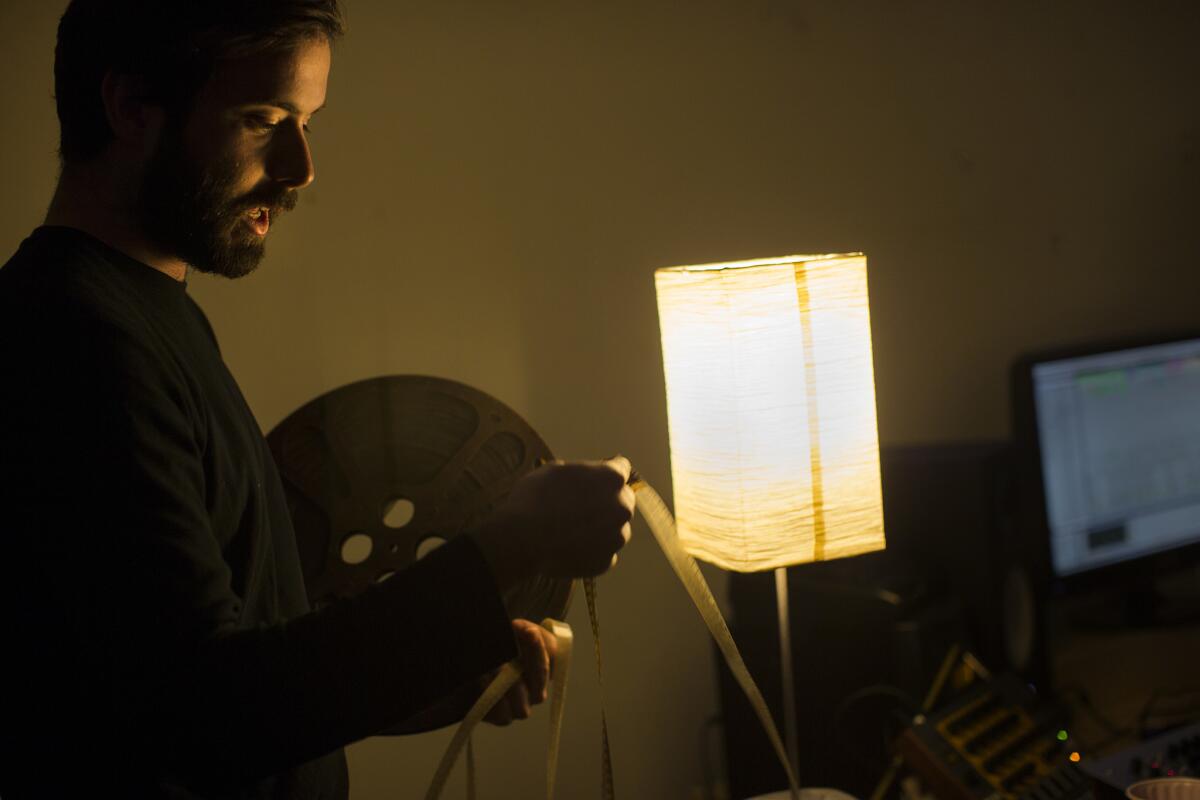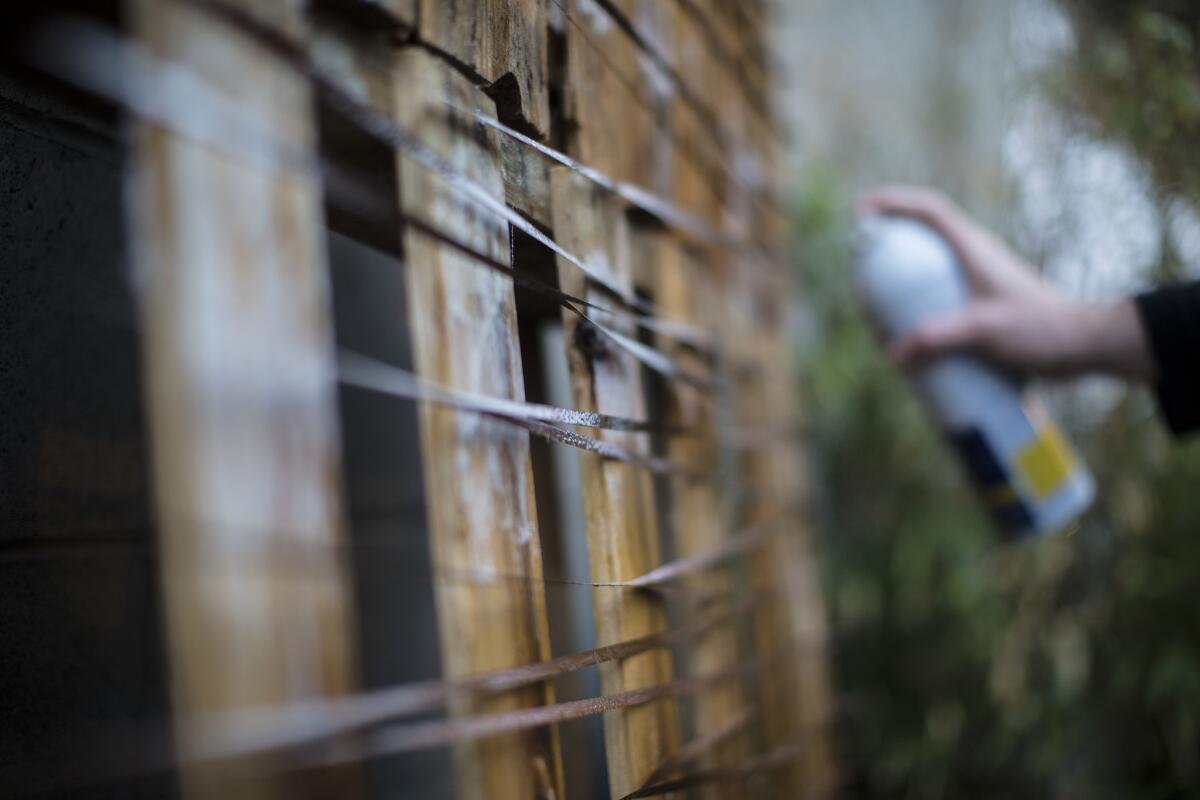Video premiere: Electronic producer Lawrence Grey’s recipe on ‘Rust’? Tape, starch and sunshine

- Share via
When working on his new album, “Rust,” Los Angeles electronic music producer Lawrence Grey tapped some unlikely materials: A used TEAC reel-to-reel recorder and old tape salvaged from an electronics repair store.
Compared with the processed nature of most such music, “tape sounds different,” said Grey, sitting amid vintage and high-tech recording gear in his storefront Koreatown studio.
A music software teacher by day, Grey, whose last name is Berkowitz, then added: “But starch and sunshine really made this happen. There’s no tape emulator that can do what the actual sun beating down on a thing can.”
While scouring the Valley, Grey dipped into a a box and pulled out a plastic bag filled with a length of tape. The ragged brown tangle contained one string of sound that he reworked for use on “Rust.”
That decay is a unifying theme to the project. The striking cover photo for the album was taken from a seemingly ruined slide, and for the video to “Starch Pariah,” Grey wrecked old 16-millimeter film. The result is a gritty mess.
Featuring 11 tracks that move with minimalist hum and otherworldly tones and textures, the album was a few years in the making and prompted by the producer’s growing impatience with what he describes as electronic dance music’s current “preset culture.”
Rather than experimenting with technology and building distinctive sounds, said Grey, many producers rely on company-produced sounds that can be manipulated with drag-and-drop ease.
At its most basic, tape is basically polyester – plastic – with iron oxide on it that is stuck to it with glue.
— Lawrence Grey
“There’s so much beautiful, modern, fast technology that allows you to make something real quick and be playing it onstage that night,” he said. “For me, that misses the whole point.”
That’s especially relevant for Grey. He founded the Young Producers Group, which travels to Los Angeles-area schools and teaches children how to use Ableton Live, the industry-standard music production tool.
As an expert, he understands the program’s strengths, as well as the ways in which amateurs can use shortcuts to make pro-sounding tracks.
“Rust” was issued by Los Angeles experimental techno imprint Proximal, which has returned from an extended hiatus to issue a few new records in 2016. The label is best known for its 2010 collection of Los Angeles artists, “Proximal Records: Narrative of a City.”
Though that record didn’t get a lot of attention at the time, its track list is notable for the inclusion of early work by Grey and now-acclaimed artists including Tokimonsta, Dam-Funk, Shlohmo and Daedelus.

Grey’s track on “Narrative of a City” isn’t nearly as dirty sounding as the new stuff, but that’s because he was working minus outside interference.
Although he up in the digital era, Grey grew curious about older means of making music, which led him to ponder analog tape.
What Grey didn’t understand until he started researching the medium is the process by which sound is captured: “At its most basic, tape is basically polyester – plastic – with iron oxide on it that is stuck to it with glue. And iron oxide is just a fancy word for rust. It’s literally ribbons of rust — which is what tape was called back in the day.”
Grey did some research with a central, albeit unprintable, question: “What can I do to … with these things?”
He learned that starch corrodes plastic, which in turn led him to wonder what weirdness might come from exposing sounds that he generated on his computer.
So Grey recorded onto tape a variety of component patterns such as synthesizer chords, keyboard melodies, bass-drum kicks or a high-hat rhythm. After banging rows of nails into a balcony guardrail at his former apartment, he snaked through strips of tape and, using store-bought starch, sprayed them down. He left them outside for a few weeks and then repeated the process.
“They sit outside and collect dirt,” said Grey. “Maybe it will rain. Maybe it will be really hot one day. You could see the physical decay.”
Once baked, the tape had to go back onto the reels, no small feat. Some strips stuck together with starch. They got damaged when Grey separated them, which rendered the sounds even more oblique. Others were caked with corroded globs that had to be cleaned off.
“The material exposes itself to you through process over time,” said Grey. “That, for me, is so valuable and so beautiful.”
Once Grey got the tape on reels, he bounced those tracks to Ableton and set about weaving the crusted sounds back into the web of the song.
At his studio, Grey launched Ableton on his computer and opened the track “JX Ghost Tape.” A checkerboard of colors lighted up his monitor, each of which represented a distinct tone, many drawn from the weathered tapes.
A freakish, wobbly batch of hissing synth tones, slowed to a crawl and whooshing with sonic specks, filled the room. When doing experiments like this, said Grey, “You encounter things that there’s no way you could have envisioned.”
Grey took the project further when he realized a visual component with film and slide photos was possible. These were media he hadn’t worked with in the past, but he attempted a similar process.
For the video of “Starch Pariah,” which The Times is premiering above, Grey bought 16-millimeter films at a San Francisco junk spot and spread strips of the footage on a friend’s roof over the summer.
After re-spooling the film, he and a friend digitized the footage by projecting it onto a sheet in his studio. Weathered and worn, the footage jumped and stuttered through the projector’s sprockets. Random images struggled to push through the dirt.
Grey then set to melding the images by wedding them to his song “Starch Pariah.”
The goal throughout was to hit that sweet spot between discarded past and lightning-speed present, said Grey.
“With the things we’ve already made, so much rich potential is still untapped. Combined with modern tools — that’s where I get really excited, and that’s where there’s so much to be done.”
For all your Southern California music needs, follow Randall Roberts on Twitter: @liledit
ALSO
For Mija, club-music success came quickly. Now she’s trying to subvert it
The Regrettes may be high-school age, but the band’s worldview is all grown up
What do She & Him want for Christmas? ‘Real instruments’ played by humans
More to Read
The biggest entertainment stories
Get our big stories about Hollywood, film, television, music, arts, culture and more right in your inbox as soon as they publish.
You may occasionally receive promotional content from the Los Angeles Times.










